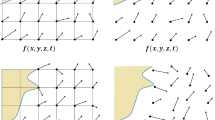Abstract
In their paper, Delgado-Buscalioni et al. (Eur. Phys. J. Special Topics, this issue, 2015, doi: 10.1140/epjst/e2015-02415-x) discuss a methodology for implementing open boundaries in molecular dynamics simulations through an outer “boundary layer” that manipulates exiting and entering particles to enforce the targeted statistical properties in the main simulation domain. Here we comment on the relation of the approach to the adaptive resolution technology “AdResS”, on the respective roles of volume and area averages in flux coupling techniques, and on the possibility of coupling MD simulations to a fluctuating hydrodynamics code.
Similar content being viewed by others
References
R. Delgado-Buscalioni, J. Sablić, M. Praprotnik, Eur. Phys. J. Special Topics 224(12), 2331 (2015)
Author information
Authors and Affiliations
Corresponding author
Rights and permissions
About this article
Cite this article
Klein, R. Comments on “Open boundary molecular dynamics” by R. Delgado-Buscalioni, J. Sablić and M. Praprotnik. Eur. Phys. J. Spec. Top. 224, 2509–2510 (2015). https://doi.org/10.1140/epjst/e2015-02535-3
Received:
Revised:
Published:
Issue Date:
DOI: https://doi.org/10.1140/epjst/e2015-02535-3




